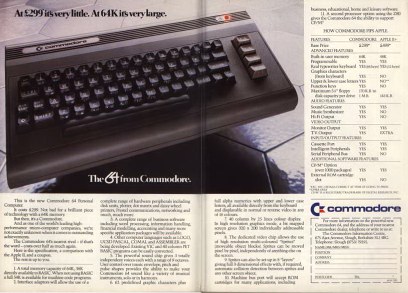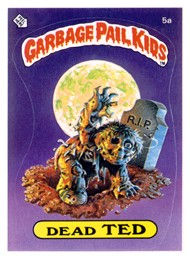The Eighties Club
The Politics and Pop Culture of the 1980s
|
   ISSUE FIVE (16 July 2003)
|
Man Goes Into Coma in 1984, Awakes in 2003
Associated Press (8 July 2003)
MOUNTAIN VIEW, Ark. - A man regained consciousness after spending 19 years in a coma as the result of a car crash, greeting his mother who was waiting at his bedside
"He started out with 'Mom' and surprised her and then it was 'Pepsi' and then it was 'milk.' And now it's anything he wants to say," Stone County Nursing and Rehabilitation Center social director Alesha Badgley said Tuesday.
Terry Wallis, 39, had been at the center since the July 1984 crash.
His father, Jerry Wallis, said his son uttered his first word June 12, was able to talk a little a day later and has improved ever since.
Terry Wallis' wife, Sandi, said her husband was riding with a friend when their car left the road and plunged into a creek. Wallis and his friend were found the next day underneath a bridge. The friend was dead and Wallis was comatose.
"It's been hard dealing with it, it's been hard realizing the man I married can't be there," Sandi Wallis said. "We all, the whole family, missed out on his company."
Wallis' daughter, Amber, was born shortly before the accident. She is now 19 and Wallis has said he wants to walk again, for her. He is a quadriplegic as a result of the crash.
His mother, Angilee Wallis, called her son's return to consciousness a miracle.
"I couldn't tell you my first thought, I just fell over on the floor," she said.
While in a coma, Wallis spent most of his time at the rehabilitation center, but his family took him out for weekends and special occasions.
"The doctor said that's why he remembers things; we might have kept his mind going," Sandi Wallis said.
Cutting Edge?
Many 1980s fashions never looked good in the first place. But now that Becks is wearing ripped denim, expect to see exposed knees in all the best places
Liz Jones, The (London) Evening Standard (18 December 2002)
Oh dear. There is nothing quite like another Eighties revival to make those of us who enjoyed their heyday in that decade to realise just how misguided we were. I was in my twenties in the 1980s, working on a glossy magazine, and so was privy to all the cutting-edge trends of the day. I wore leg warmers (pink or blue) on my ankles and my arms, for reasons I still cannot quite explain.
I wore batwing sleeves shot with Lurex that knocked over cups of coffee everywhere I went, and shoulder pads so wide my head resembled a pea. I drew the line at puffball skirts and one-shouldered tops, but adopted as a uniform "the body" -- a hideous item of clothing, invented by Donna Karan, that resembled a leotard, but with rather painfully placed poppers. I wore black Lycra leggings, sometimes with stripes down the side, sometimes plain, almost every single day. I look at pictures of myself at the time and can only marvel that nobody pointed out my uncanny similarity to Max Wall.
All of the above looks (which, let's face it, were never good) have been revived by designers over the past few seasons and road-tested by young women not old enough to remember Bros, let alone Sonia.
But one fashion trend that is refusing to go away is that of ripped denim jeans. Billie Piper wore a pair to go Christmas shopping with husband Chris Evans earlier this week; the fact that she was clutching a Harrods bag must mean the store has relaxed its door policy of no shorts, no rucksacks and no fashion victims....
And David Beckham was seen coming out of a nightclub last weekend in a pair of Levis he had customised himself, worn with a denim jacket and a leather coat by William Hunt. He just about pulled it off and looked cool, if underdressed, next to his wife, Victoria, who was being loyal as always to Dolce & Gabbana.
She needn't worry, though; Dolce have included a pair of baby-pink ripped jeans in their spring/summer collection.
Oh, I forgot to mention that another Eighties staple, pastels -- first made fashionable by Sonny Crockett in Miami Vice -- will be everywhere next season.
In true Miami Vice style, expect, very soon, to see a picture of David Beckham with his jacket sleeves pushed up to his elbows, sporting a pair of loafers worn without socks....
Where would you dare to flaunt those jeans?
Harrods: No problem at all. "We're more relaxed these days and the ripped-jeans style has changed -- the massive rip along the backside isn't so common now, which we might frown upon," says a spokesman....
Cecconi's: The upmarket Italian W1 restaurant has Guy Ritchies as a regular, who often turns up in jeans. "We're quite relaxed about denim these days," says the manager, John Davey, "just as long as they're not cutoff jeans and you don't have your bum hanging out."
The Ivy: This famous Covent Garden restaurant is probably the only place in town where you can see the smartly dressed Camilla Parker Bowles in the same room as scruffy Liam Gallagher. "We get people ringing up asking if they need to wear a tie," says a spokesman. "But people can wear whatever they want. That goes for everyone, not just celebrities. Ripped jeans are fine."....
(c) 2002 Associated Newspapers, Ltd.
 Nike Gets Foothold in "Retro" Shoe Market
Justin Pope, Associated Press (10 July 2003)
Nike Inc. is leaping into the retro-shoe market by buying Converse Inc., which has sold more than 750 million pairs of its classic canvas and rubber "Chuck Taylor All Stars."
Under the deal announced Wednesday, Nike, the top maker of high-tech athletic shoes, will pay $305 million and assume certain Converse liabilities.
Nike overtook Converse as the dominant basketball shoemaker in the 1980s. After battling Nike and Reebok's surging popularity for nearly 20 years, Converse filed for bankruptcy in January 2001, shifting production from Lumberton, N.C., to Asia.
Later that year, the North Andover-based company was bought by private investors who have tried to revive the brand.
Last year, Nike had $10.7 billion in revenue, while Converse reported $205 million.
Robert Toomey, an analyst for RBC Dain Rauscher in Seattle, said Nike was probably looking to cash in on the popularity of "retro" shoes and Converse's close brand association with basketball, particularly for Americans who grew up in the 1950s and '60s.
Earlier this year, New Balance relaunched its PF Flyers canvas sneakers, jumping on the retro bandwagon.
"Retro styling has come back so strong, a lot stronger than I would have expected," Toomey said....
Converse invented basketball shoes in the early days of the game, and "Chucks" got their name from Chuck Taylor, a Converse salesman who traveled the country from the 1920s until the 1960s, evangelizing the game and selling shoes.
But by the 1970s it was crippled by internal problems — including the disastrous acquisition of apparel-maker ApexOne.
There was also bad luck. Nike signed Michael Jordan, who became the NBA's greatest star. Converse signed Latrell Sprewell, who tried to choke his coach during practice and was dropped as an endorser.
During the 1980s, Chuck Taylor shoes, which the company still sells, enjoyed a renaissance. But this time the customers were grunge rockers and baby boomers, not basketball players. Its "Grandma-ma" ads with basketball player Larry Johnson were a hit, but sales continued to sputter.
Apparel-industry veterans Marsden Cason and William Simon bought the company out of bankruptcy and tried to rebuild Converse's reputation as a maker of top-of-the-line basketball shoes.
Converse did expand its brands with the Jack Purcell and One Star brands, and the company has made some progress. The year before bankruptcy, sales were $145 million.
The deal, which remains subject to regulatory approval, would give Converse the deep-pocketed backing and marketing depth to push its brand worldwide, while offering Nike a fashion niche it may have been missing....
(c) 2003 Associated Press
Duran Duran Follow Beckham Formula in Comeback
Alastair Himmer, Reuters (3 July 2003)
Pop legends Duran Duran, famous for a string of smash hits in the 1980s, have been taking style tips from England soccer captain David Beckham in preparation for their latest comeback.
The British band, who begin a world tour in Japan next week, declared they were back for good after a protracted period of declining record sales and expanding waistlines.
"We all follow the David Beckham regime -- his hairdressing regime that is," keyboard player Nick Rhodes told reporters on Thursday.
He said the band had been recording for a year and a half, on and off. "The new album is near completion. The tour is to get some energy for the final recording."
Duran Duran, who have sold over 60 million albums since releasing their first single, "Planet Earth," over 20 years ago, insisted they were no 1980s revival act, appearing at a Tokyo news conference looking slim and dressed in black suits.
"These guys had very successful records in the 1990s, so this is not just some revival band," said drummer Roger Taylor, who retreated to the English countryside after quitting in 1985.
Bassist John Taylor, whose attempt to break into Hollywood peaked with a role in the 1999 Flintstones movie "Viva Rock Vegas," said he was happy to be back with Duran Duran following an acrimonious split.
"It's all about chemistry. That only happens once in a lifetime if you're lucky," he said.
Although often ridiculed for videos that showed them perched on elephants or the front of yachts wearing silk suits, more than 50,000 Internet pages are devoted to Duran Duran, who counted the late Princess Diana among their legions of female fans during the 1980s with such hits as "Girls on Film" and "Hungry Like the Wolf."
Their penchant for eyeliner and hairspray still intact two decades on, the 40-something rockers have added an extra date to their Japan schedule after selling out one Tokyo venue in less than 30 minutes.
"We wanted to start the tour somewhere where we could be sure of a good reception," said singer Simon Le Bon, who has been in the tabloids as much for his racy lifestyle and occasional boating accidents as his involvement with Duran Duran.
"Being in a band keeps you young and wild at heart."
(c) 2003 Reuters
When Sources Go Bad
Greg Krikorian, Los Angeles Times (9 July 2003)
He walked into the Dallas office of the FBI late on a Friday afternoon in 1980. Frank Varelli said he had information about some killings in his native El Salvador. He listed dates and places. He named names.
"We contacted the CIA and they verified the killings were committed," recalled Gary Penrith, then acting head of the FBI office. "So this guy looked like he might be giving us reliable information."
With the FBI's blessing, Varelli infiltrated the Dallas branch of a group he said was behind the slayings — the Committee in Solidarity with the People of El Salvador, which opposed U.S. policy in Central America. Varelli reported, among other things, that members of the group were plotting to assassinate President Reagan. The FBI launched a massive investigation.
Years passed. Penrith went on to Washington to become one of the bureau's highest-ranking intelligence officials. Then he got the sickening news: Varelli had concocted his allegations. The investigation had been a costly waste of time.
"He was a wacko," said Penrith, one of six FBI officials disciplined for the embarrassment. Instead of receiving a hoped-for promotion to assistant director, he finished his 24-year career running the FBI's Newark, N.J., office.
"I'm not crying the blues," he said. "I'm just telling you what happens when an informant goes bad."
Whether investigating a terrorism conspiracy or trying to bust a burglary ring, authorities depend on insiders willing to share information. Yet dealing with informants is a treacherous business. Sometimes, as in Varelli's case, they mislead their handlers. Sometimes they seduce them. Sometimes they corrupt them. And sometimes, they turn the tables, leaking state secrets to foreign governments.
In April, authorities in Los Angeles arrested a Chinese American informant and alleged that she carried on affairs with two FBI counterintelligence agents who supervised her activities. The informant, Katrina Leung, allegedly passed classified information to the Chinese government. She has denied any wrongdoing.
Last fall, John J. Connolly Jr., a former FBI agent in Boston, was sentenced to 10 years in federal prison for protecting the sort of gangsters he was supposed to put behind bars.
Connolly became so close to his mob informants that he looked the other way while they committed extortion, ran bookmaking operations and allegedly killed rivals.
In an earlier but no less sensational case, Mark Putnam, an FBI agent in Kentucky, strangled an informant in 1989 after she threatened to expose their affair and her pregnancy....
FBI and congressional investigators are examining the recent scandals in Los Angeles and Boston, searching for insights into what causes some agent-informant relationships to go bad.
Sharing Secrets
....Rick Smith, a retired counterintelligence agent from San Francisco, said that anyone peddling information about a foreign government needs special scrutiny.
"You have to figure out why they're talking to you," Smith said. "Because ultimately in counterintelligence, when you get someone to be a mole, they are betraying their country. And you need to know why."
In many cases, money is the motivation.
Smith recalled a European businessman whom the FBI recruited in the early 1980s to help foil espionage efforts by Soviet and Eastern European agents. In one case, the foreign agents asked the businessman to help them buy sophisticated computer equipment from the U.S.
"We found out about it," Smith said. "And we were able to alter the equipment and send them back things that didn't work."
The foreign agents went to a government-sponsored trade show in Sofia, Bulgaria, to show off their newly acquired gear, and were embarrassed. "They turned the stuff on and it didn't work," Smith said, chuckling.
Afterward, the European businessman felt he was worth more than ever to the FBI. "We'd already paid him a lot of money over the years, hundreds of thousands of dollars," Smith said. Now, the man was demanding $2 million and threatening to quit if he didn't get it.
"So I let him go," Smith said. "You can't be extorted. You can't let that happen."
Informant Ted Eley, who helped the FBI bust a Kentucky drug operation nearly 20 years ago, had a different motivation.
An ex-con, he hoped to be pardoned by the governor so he could regain the right to vote, recalled FBI agent Nancy Savage, who for years has taught colleagues how to develop criminal sources.
"He was a decent guy a really significant informant in a major drug case," said Savage, now an agent in Portland, Ore., and president of the FBI Agents Assn. "He bought the drugs, wore a wire several times. He was willing to go the whole nine yards."
Eley helped the FBI obtain convictions against 13 people who were running the nation's third-largest methamphetamine lab in Hog Wallow, Ky. But he never received a pardon for his own, earlier drug conviction....
Some informants try to treat their handlers like friends, even family.
"You have to keep in mind it is a business relationship," said Bill Gore, a former assistant director of the FBI's inspection division. "On the other hand, if you have a good asset, it is hard not to develop a friendship. The stakes are extremely high, and if you have a valuable asset, it is hard not to go beyond an arm's-length relationship."
It certainly was hard for Connolly, the disgraced former agent. He grew up in a South Boston housing project and bragged that his credentials as a "hometown boy" gave him special access to the New England underworld.
In 1975, Connolly recruited mob boss James "Whitey" Bulger, a childhood friend, as an informant. The relationship lasted nearly 20 years and was corrupt to the core. Connolly protected Bulger, tipping him to investigations into his activities and even identifying disloyal members of his gang. Bulger reciprocated with information about his mob competitors.
Connolly became a star in the FBI, and Bulger and his associates enjoyed a kind of impunity as they ran drugs, continued gambling operations and did away with rivals.
Connolly delivered bribes from Bulger to an FBI supervisor. He wrote an anonymous letter on Boston police stationery that accused a local detective of falsifying evidence against Bulger and his top lieutenant, Stephen "The Rifleman" Flemmi.
Four years after retiring from the bureau, Connolly tipped Bulger in 1994 that he was about to be indicted on extortion, murder and racketeering charges. Bulger disappeared and remains on the FBI's 10 Most Wanted list.
Back in 1983, Connolly taped an FBI training video in which he warned new agents against becoming too cozy with gangsters. "You can get friendly with them and you can like them," he said. "But you can never forget who you work for and that you're an FBI agent."
Mark Putnam would have done well to consider that advice. Thirteen years ago, he became the first FBI agent ever charged with murder.
A married father of two, Putnam was seen as a rising star in the bureau. Then he began to spend time with Susan Daniels Smith, an informant in a Kentucky bank robbery case.
"We were in the car one night, Susan and I talking, and she sensed that I was down, and we just came together right there," Putnam said in a 1993 jailhouse interview with ABC-TV.
"I knew right at that point that I had compromised everything that I had worked for, because I broke the first rule of an FBI agent-informer relationship: Never sleep with your informant."
Smith, 28, became pregnant. In June 1989, Putnam strangled her, dumped the body off a coal-mining road in eastern Kentucky and returned to his wife and children.
A year later, Putnam confessed to the crime and led authorities to Smith's body. In return, he was allowed to plead guilty to manslaughter.
Putnam said he killed Smith because she was threatening to expose their affair. He was sentenced to 16 years in prison and paroled in 2000.
Agents say that such egregious misconduct is extremely rare and that FBI regulations, peer pressure and rigorous monitoring usually prevent agent-source relationships from becoming too intimate....
The more valuable the informant, the closer the bureau guards his or her identity. Penrith, the former top FBI official, said the names of double agents providing foreign intelligence were known only to a handful of senior officials.
Leung, the Chinese American informant arrested in April, carried on a clandestine affair with her FBI handler, James J. Smith, for nearly 20 years, authorities said. For much of that time, Smith was head of the FBI's Chinese counterintelligence squad in Los Angeles.
A prominent San Marino businesswoman, Leung began providing information on China in the early 1980s. During regular visits to her home, Smith would leave his briefcase unattended and Leung would remove and photocopy documents, according to FBI affidavits.
Smith knew as early as 1991 that Leung was secretly communicating with Chinese agents, but he continued to vouch for her credibility with higher-ups, authorities say.
The Double-Cross
Smith learned of Leung's improper contacts from his FBI counterpart in San Francisco, William Cleveland Jr., who had heard Leung's voice on an intercepted conversation with a Chinese agent, FBI affidavits say.
Cleveland, it turned out, was also having an affair with Leung.
Leung is charged with obtaining and copying national security documents. Smith, who retired from the FBI in November 2000, is accused of gross negligence. Both have pleaded not guilty. Cleveland, also retired, has not been charged and is cooperating with authorities.
For all the potential pitfalls, current and former agents say, there is no exaggerating the importance of reliable informants. Many cite the case of Raymond J. Takiff, a flamboyant Miami defense attorney who played a key role in an FBI corruption probe called Operation Court Broom.
Takiff approached authorities in August 1989 and claimed that Roy Gelber, a judge on Florida's highest trial court, was corrupt. "He offered immediately to wear a wire," said retired FBI agent Tom Becker. "He was crucial, critical to the case. Without him, we would have had nothing."
Takiff recorded about 500 conversations with the judge and other principals that showed Gelber could be paid to fix cases.
The judge pleaded guilty to racketeering and agreed to cooperate. Nearly a dozen Dade County judges and defense lawyers ultimately were convicted in the probe.
Takiff, who died five years ago, never shared with Becker his reasons for helping the FBI. "My guess," Becker said, "was that he wanted to do something good."
(c) 2003 Los Angeles Times
 A Commodore 64 advertisement of the '80s
Commodore 64 Makes A Comeback
David Legard, IDG News Service (14 July 2003)
Tulip Computers, which owns the Commodore brand name, plans to relaunch the brand to take advantage in an upsurge of interest in the obsolete Commodore 64 (C64) computer and its 1980s-era games, the company said in a statement Friday.
Tulip estimates that there are still 6 million Commodore users, who can choose from a range of 6,000 games which were developed for the system.
Tulip is working with Ironstone Partners, which will handle all sales of Commodore 64-related products worldwide and take over the main C64 Web portal. Enthusiasts have made over 10 million game downloads, the site owners have said.
Unauthorized use of the Commodore name by other organizations will be stopped, Tulip said in the statement.
Playing Games
Even if the Commodore 64 hardware is obsolete, enthusiasts have written emulators for Windows PCs, Apple Macintoshes, and now PocketPC-based PDAs to enable original Commodore games to run on those systems.
Commodore was one of the pioneers of the PC industry, entering the market in 1977 with its 8-bit PET (Personal Electronic Transactor). The C64 was launched in 1982, followed a few years later by the Amiga.
Slowly, the crucial graphics edge that these systems enjoyed was eroded by successive improvements in Microsoft's Windows OS, and Commodore went into liquidation in 1994. Tulip, based in Amersfoort, Netherlands, bought the Commodore brand name and other assets in 1997.
(c) 2003 PC World Communications, Inc.
Fables of Finance
Investor's Business Daily (16 July 2003)
The budget deficit is expected to jump to $450 billion this year, causing some deficit hawks to warn of a growing "crisis." Sorry, but the crisis doesn't exist.
Those who fear the deficit seem surprisingly immune to any lessons from history.
For history shows that most of what we hear about the deficit is wrong. This deficit, in the truest sense, isn't a "record." It's not even close. This year the deficit will come in at about $455 billion, or 4.2% of GDP, which is the most meaningful way to measure spending gaps. How big is that? It doesn't even make the top five since 1980.
Yet we're repeatedly warned that record deficits will drive up interest rates. The logic behind that thought, while impeccable, isn't supported by reality.
Let's look at the record. At the start of the 1980s - another period of "record" deficits - the 10-year Treasury yield got as high as 15%.
Despite the continued presence of deficits, the 10-year sank to 8% by the end of the 1980s. Interest rates continued to fall during the 1990s. By 2000, the U.S. had triumphed, posting a record surplus. Yet the 10-year Treasury note was still over 6%.
Since then, the deficit has surged. So interest rates have surged too, right? Nope. Long rates are below 4%. It's pretty clear. If there is any link at all between deficits and interest rates, it's very weak.
But now that the White House, as one headline put it, "admits" to the "record" deficit, deficit foes say it's clear something has to be done. But what? In fact, what we're seeing right now is entirely normal. After an economic downturn, the deficit always gets worse.
It's a pattern that can be seen in each of the last three recessions. Since 1980, the deficit has averaged 4.5% of GDP in the year after the economy bottomed - just about where it is now.
The reason for this is simple. A shrinking economy brings in less money. So the government spends like crazy to make up the difference, and the deficit gets worse. But as the economy starts to grow again, the deficit-to-GDP ratio will shrink sharply. It always does.
We're not Pollyannas. We don't say deficits are good things. Or that the government should just spend without heed. It shouldn't.
But excessive fear of deficits is often used as a bludgeon against good ideas like tax cuts, which inarguably lead to higher growth and a healthier economy. Meanwhile, as those who oppose tax cuts wail, Congress is boosting spending at an 8% annual clip....
In the meantime, relax. This is no record deficit. Back in 1943, during WWII, the deficit hit 30.3% of GDP. Now, that was a record.
© 2003 Investor's Business Daily
  Brace Yourself: Garbage Pail Kids Return
Lukas I. Alpert, Associated Press (11 July 2003)
Long before "South Park" or "Beavis and Butt-Head" entertained kids with lowbrow toilet humor, there were the Garbage Pail Kids. Now, the grandfather of gross-out is making a comeback.
After being off the market for 15 years, a new series of the hugely successful stickers that entertained children in the mid-1980s with depictions of bodily functions will be released in August by The Topps Co.
Garbage Pail Kids still maintain a cult following, with several dedicated fan Web sites and an active trade on Internet auction sites.
But will the stickers, originally conceived as a spoof of the wildly popular Cabbage Patch Kids, find an audience among a jaded generation raised on the hyper-potty-humored "Jackass" and the sophomoric "SpongeBob SquarePants"?
"I think gross-out has always been and will always be of interest to kids," said Arthur T. Shorin, chairman of Topps, whose Manhattan headquarters is crowded with mountains of candy and collectible cards. "Garbage Pail Kids was a phenomenal fad — it really struck a funny bone — and we expect kids will still enjoy them because it's a spoof on real life."
The new series finds plenty of new things to make fun of, like "Fartin' Martin," who gaseously propels himself on a Razor scooter, or the heavily pierced "Metallic Alec," who is pulled out of his shoes by a magnet.
They even take a shot at the bespectacled child wizard — "Harry Potty" — toilet plunger in tow, doing his business in the loo.
To help modernize the series, Topps also plans to launch a Web site in August that will let youngsters create their own Garbage Pail Kids and take a tour of a Garbage Pail Kid city.
Not all the ideas are new. About two-thirds of the series is made up of art drawn for stickers 15 years ago that were never released.
The maker of baseball trading cards and Bazooka bubble gum made millions of dollars on 15 different series of Garbage Pail Kids from 1985 through 1988, Shorin said. The unreleased art was drawn for the 16th series, which never saw print because the stickers' popularity had waned.
Garbage Pail Kids suffered a backlash of sorts from parents who thought gross-out humor was detrimental to children — something that probably spurred their popularity.
"I would get letters all the time from parents saying, 'This is in poor taste.' Well, of course it's in poor taste!" Shorin said. "But it's not in wrong taste; we would never do that."
Some are still skeptical about Garbage Pail Kids.
"I'm kind of surprised they're releasing it, because I think kids may be beyond this," said Mark Long, author of "Bad Fads" and operator of the Bad Fads Museum Web site.
Shorin argues the stickers' unsavory concepts can actually be educational for children.
"Garbage Pail Kids deals with bodily functions and death and dismemberment, which kids are very much aware of, but it deals with it in a humorous way, which helps kids confront these things."
© 2003 Associated Press
 The Eighties Club is not affiliated in any way with any of the publications from which these excerpts were derived, and does not profit in any way from the purchase of the complete articles. These excerpts are provided for educational purposes only.
|